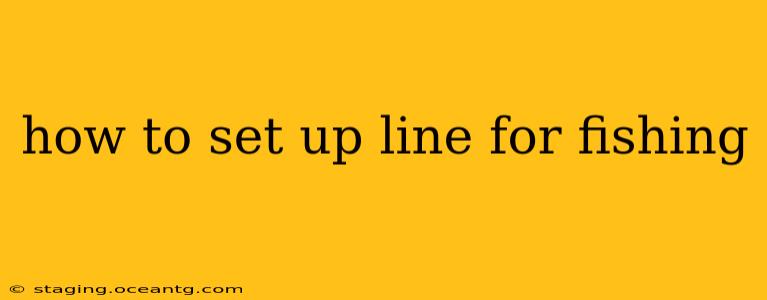Fishing can be a relaxing and rewarding hobby, but mastering the art of setting up your fishing line is crucial for a successful outing. This comprehensive guide will walk you through the process step-by-step, covering everything from choosing the right line to tying the perfect knot. Whether you're a seasoned angler or just starting out, this guide will help you confidently set up your fishing line for any fishing adventure.
Choosing the Right Fishing Line
Before you even think about tying knots, selecting the appropriate fishing line is paramount. The type of line you choose will significantly impact your fishing experience. Several factors influence this decision:
-
Type of Fishing: Are you targeting large game fish, or smaller panfish? The strength and type of line needed will differ greatly. Heavy-duty braided lines are often preferred for larger fish, while lighter monofilament lines work well for smaller species.
-
Water Conditions: Clear water often calls for low-visibility lines like fluorocarbon, which is less detectable to fish. Murky water allows for more visible lines like bright green or yellow.
-
Personal Preference: Some anglers swear by certain types of lines due to their personal experiences and preferred fishing styles. Experimentation is key to finding your perfect match.
Popular line types include:
- Monofilament: A single, solid strand of nylon, known for its flexibility, knot strength, and relatively low cost.
- Fluorocarbon: Similar to monofilament but with a higher refractive index, making it nearly invisible underwater. It’s stronger and more abrasion-resistant.
- Braided Line: Consists of multiple interwoven fibers, offering superior strength and sensitivity. However, it can be more expensive and prone to wind knots.
What Size Fishing Line Do I Need?
The appropriate line size is determined by the type of fish you're targeting and the fishing conditions. Line size is usually expressed in pounds (lb) test, referring to the amount of weight the line can hold before breaking. A higher pound test means a thicker, stronger line. Consult fishing charts or guides specific to your target species and location for recommended line weights. Generally speaking:
- Lighter lines (4-8 lb test): Ideal for panfish, trout, and other smaller species.
- Medium lines (10-15 lb test): Suitable for bass, walleye, and other medium-sized fish.
- Heavy lines (20 lb test and up): Necessary for larger game fish like catfish, salmon, or tuna.
How to Properly Spool Your Fishing Reel
Once you've chosen your line, spooling your reel correctly is crucial for smooth casting and preventing line tangles. Here's how:
-
Secure the Line: Begin by firmly tying your line to the spool of your reel, usually via a small arbor knot.
-
Even Winding: Slowly and evenly wind the line onto the spool, ensuring there are no overlaps or gaps. Many reels have a line level indicator to help you achieve this.
-
Fill the Spool Appropriately: Don't overfill or underfill the spool. Overfilling can lead to line tangles, while underfilling reduces casting distance and strength.
Tying Fishing Line Knots: The Essential Guide
The right knot can mean the difference between landing a trophy fish and losing it. There are many fishing knots, but some are more popular and reliable than others. A few essential knots include:
-
Improved Clinch Knot: A classic and highly reliable knot for attaching lures and hooks. It's easy to learn and widely used.
-
Palomar Knot: Another strong and easy-to-tie knot, especially useful for larger hooks and lures.
-
Uni Knot: Excellent for attaching braided line to monofilament or fluorocarbon leaders.
Practice tying these knots until you can do them quickly and consistently. There are many tutorials online and in fishing books that visually demonstrate how to tie these knots.
How Do I Attach My Fishing Line to a Hook?
Once you have your line spooled, you need to attach it to your hook. This is done using the knot you chose (Improved Clinch Knot is a good starting point). After tying the knot, carefully trim the excess line leaving about a quarter of an inch, preventing tangling and improving the lure's movement in the water.
What Are the Different Types of Fishing Line? (People Also Ask)
This question is already addressed above in the "Choosing the Right Fishing Line" section. The key types are monofilament, fluorocarbon, and braided line, each with its own strengths and weaknesses.
What Knot Should I Use to Tie a Fishing Line? (People Also Ask)
There are many effective knots, but the Improved Clinch Knot and Palomar Knot are excellent choices for beginners due to their strength and ease of tying. The Uni knot is great for connecting different line types. Choosing the right knot often depends on the application and the type of line used.
How Much Fishing Line Should I Use? (People Also Ask)
The amount of line you use depends entirely on your fishing situation. Generally, start with enough line to reach your target fishing depth and add extra for casting distance and potential fish runs. However, avoid overfilling the reel.
How Often Should I Change My Fishing Line? (People Also Ask)
The frequency of line replacement depends on usage and conditions. Regular inspection is crucial. Look for signs of wear, such as fraying, abrasions, or discoloration. Damaged or old line weakens, increases the risk of breakage, and can impact your catch rate. Replace your line as needed, ensuring a reliable connection to your hook and lure.
Conclusion
Setting up your fishing line correctly is a fundamental skill for any angler. By understanding the different types of line, choosing the appropriate size, and mastering essential knots, you'll significantly improve your fishing success and enjoyment. Remember, practice makes perfect – so get out there, experiment, and tighten your lines!
